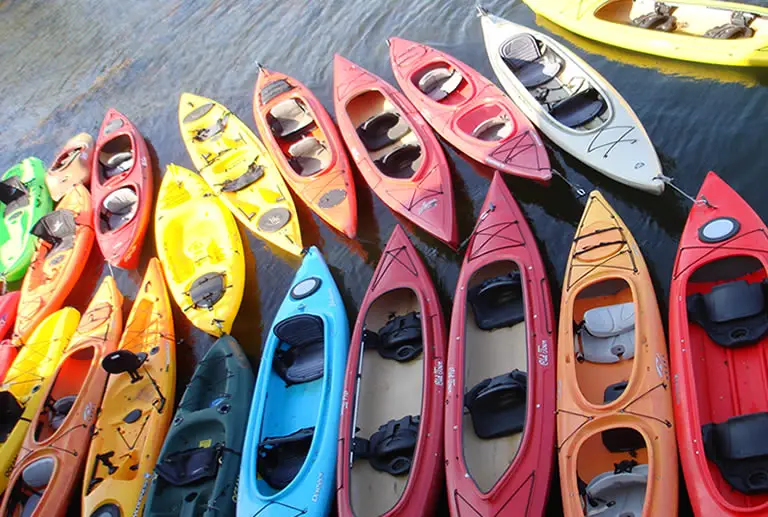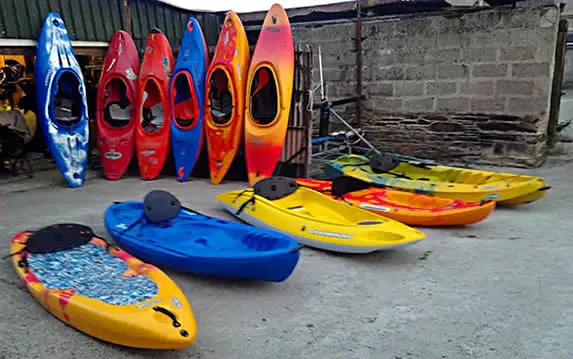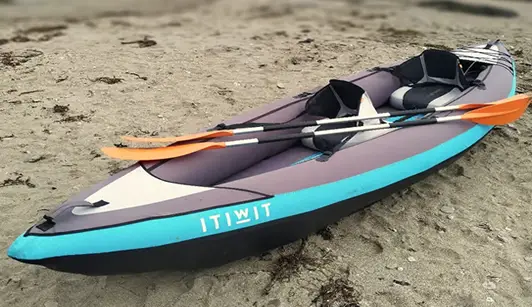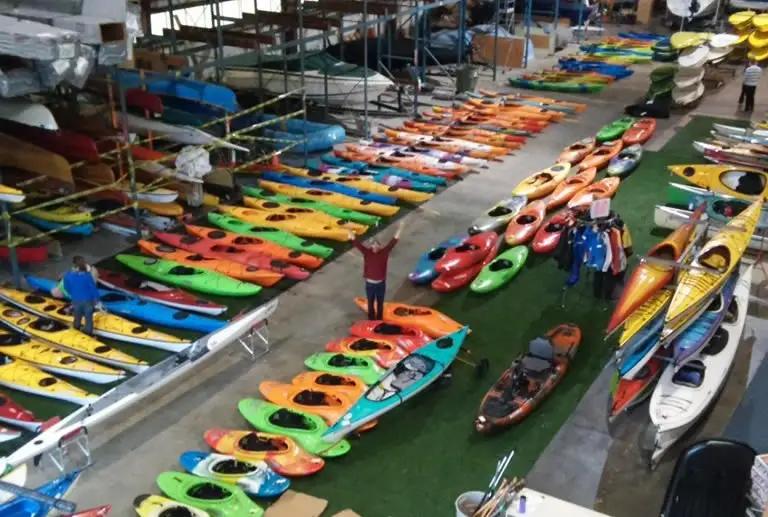Contents
- The Typical Cost Of A Used Kayak
- Used Kayak Buying Guide
- The cost of buying a used kayak may be more than monetary if you get it wrong
- Before you buy used, first know the price the same kayak when it’s new
- Consider the condition of the boat compared to its price tag
- Check the used kayak for damage or signs of repair
- Ask how the kayak was stored
- Check the fittings are secure
- Summary – the cost of a used kayak and used kayak buying guide
The Typical Cost Of A Used Kayak
So how much should a used kayak cost?
A used kayak in good condition should be approximate 50% – 75% of the price it would cost to buy new.
Some kayaks will hold their price better than others.
Expensive kayaks made from high quality material such as Kevlar keep their price well because they are durable and demand is high.

Whether you want to ride rapids in whitewater, surf on ocean waves, tour around the sea or just cruise quietly down a river or canal a kayak can offer you it all.
But because new kayaks can be so expensive many people want to know how much they should pay for a used kayak.
The amount you pay for a used kayak depends on the condition the boat is in and its current price new.
Unfortunately, there is no set price that can be laid out for used kayaks as all boats are different.
However, a good rule-of-thumb is to expect to pay anywhere from 50% to 75% of the kayak’s current price when it is new.
Some kayaks will hold their value much better than others due to high demand and the material with which they are made.
For example, Kevlar kayaks are almost indestructible.
As long as the current owner has not taken a hatchet to it and has looked after it reasonable well a Kevlar kayak a few years old could be in as good a condition as when it was first bought.
Used Kayak Buying Guide
Due diligence is required with any purchase.
This is especially true when buying used goods.
The cost of buying a used kayak may be more than monetary if you get it wrong
When you don’t do your homework on a product you intend to buy used then you could get scammed out of more money than you should have spent.
However, when it comes to boats (and vehicles in general) failing to arm yourself with the correct knowledge before making a purchase could cost you more than just money!
When buying a used kayak you must know what to look for or you could end up not just losing money on a dud, but you could end up buying something that is dangerous to use.
Below is a quick guide to buying a used kayak.
Before you buy used, first know the price the same kayak when it’s new
The first thing you should do is check the current price of the kayak, if you were to buy one new.
By knowing the price of a new model you will be able to quickly see how close the used price is to the new price.
You’d be surprised by the amount of people who try to sell used kayaks for as much as 95% of a new one. Pass!
Be aware that not all new kayaks cost the same.
Some kayaks are much more expensive than others so be sure to price the kayak you are considering buying with the same model new or as close to that model as you can get.
Also be sure you are pricing the kayak on its type.
It is silly to try to compare the price of a sea kayak to a whitewater kayak or a Kevlar kayak to a plastic one.
Likewise comparing the price of a used sit-in kayak to a used sit-on-top kayak is also unwise (if you need a detailed explanation of the differences between these two types of kayak read this article).
Now, as long as the used kayak is priced in a range between 50% and 75% of its price new, then you can then proceed to check if the price is worth the product.
You do this by checking the boat for damage.
Consider the condition of the boat compared to its price tag
Just because a kayak seems to have a low price tag that doesn’t mean you are getting a bargain.
It may be worth nothing.
Likewise, just because a kayak seems highly priced that doesn’t mean you are getting ripped-off.
It might be worth every penny or more.
It’s all about the condition of the boat.
Check the used kayak for damage or signs of repair
Once you are satisfied that the kayak price is within a reasonable range you should check the boat for potential problems.
A kayak is a pretty small vessel and easy to lift and turn over so it should not be a problem inspecting the entirety of the boat.

Kayaks are also usually molded from one material, such as plastic (polyurethane), fiberglass or a composite material such as Kevlar, so any repairs are pretty easy to spot.
Previous damage to a kayak, not matter how good the repair job is, immediately lessens its value.
If the kayak is currently damaged then it will cost money to repair it.
Try to ascertain the costs of that repair, (a quick phone call to a local dealer or kayak store should do it), and take that cost off the asking price when negotiating. I would personally just walk away though and find another kayak with no damage.
Ask how the kayak was stored
One thing that affects the condition of a kayak, and thus its value and price, is how it is stored.
This is especially true of a polyurethane kayak.
Plastic kayaks are the most vulnerable to the type of warping that occurs from improper storage conditions.
If a plastic kayak has any signs of warping, which you can check by flipping it over, or has small scrapes or gouges these can be repaired fairy easy with just heat and pressure.
These minor damages can be used as a negotiating point with the seller though as it will take time and effort to complete the repairs.
Deep dents and thin points in the kayak however are much more serious.
Damage like this could be an indication that it has taken some very serious abuse.
It may have been dragged along the ground regularly during transportation or portaging for example.
These are much more serious issues and the kayak is probably not worth buying at all.
Although the hull can show signs of poor storage, and improper transportation, it is the fittings of the kayak that will show these things up the most so you must also check them
Check the fittings are secure
Damaged fittings are something that can be easily overlooked when buying a used kayak.
A kayak that looks in good condition on first sight and that seems to justify its high price tag may not be worth half the price when you check the fittings.
Fittings to check before agreeing a price:
- Hatches.
- Foot pegs.
- Seats and knee pads.
- Storage cords.
- Bolts.
- Pedal mechanism.
- Rudder or skeg.
Let’s look at how to check these fittings a little closer to see what you should be looking for.
Hatches must be watertight
Most kayaks have storage areas in their hull for keeping gear and personal items.
Sea kayaks have quite large storage areas for boat camping and touring.
All kayak hatches have sealed covers.
If these are damaged the hatch will let in water thus making the storage compartment completely useless.
Unfortunately, hatch covers can rot or get broken fairly easily.
You may come across a few kayaks for sale that have missing hatches, or hatches with missing or damaged rubber seals.
If this is the case then it costs money to replace these.
Missing or damaged hatches reduce the value of the kayak and this should be factored into your offering price.
Though I would just look for a different kayak.
Foot pegs must be in good working order
Foot pegs, also known as foot braces, help the paddler brace themselves firmly in the cockpit or seat.
They are also important for helping maneuver the kayak.

Although foot pegs are very easy to replace you should make sure the price of a used kayak, that doesn’t have them, is reduced for the inconvenience of replacing them.
Seats and knee pads should be in good condition or easily replaceable
Kayak seats are usually removable and easy to replace.
More often than not kayak seats are made from polyurethane and nylon. Be sue they are secure and in good condition.
If they are not, price replacements and be sure the seller deducts those costs from his/her asking price.
Knee pads can be located on the inside of a sit-in kayak and are used to help make the kayaker more comfortable and snug in the cockpit.
To check theses look at a new model of the same kayak to see the ones in the used boat are original or replacements and to see what type of condition they are in.
Just because they look okay doesn’t mean they are.
Factor these replacements into the price you are willing to pay for the kayak.
Storage cords should be strong with no frayed edges
Kayaks are normally fitted with bungee cords or rope which is used for storing things.
Kayak cords are subject to damage especially from UV rays, saltwater, and the general elements.
So check the cords for frayed edges and brittleness.
If these cords are not in pristine working condition they will need replaced and the new cords will need lashed to the kayak.
The price you pay for the boat should reflect the time and hassle of replacing these cords.
Bolts must be corriosion-free
Fittings on a kayak are usually attached via stainless steel bolts. Sometimes screws will be used.
As a kayak spends a lot of time in the water these bolts are vulnerable to corrosion.
If the kayak is stored outdoors then it is not a matter of if the corrosion takes place but when. So always check these.
If a bolt is corroded it can be difficult to remove so it can be replaced.
Forcing it out can damage the hull. Oil, or better still WD 40 spray, will be needed to loosen these bolts enough to make them easy to remove.
Again this will affect the price of a used kayak.
The pedal mechanism must work correctly (this is non-negotiable)
If you are planning to buy a used pedal kayak then it is vital you check the propulsion mechanism.
Pedal kayaks are so expensive mainly because of this small device and if it is damaged on a kayak you buy, you will have wasted your money.
A typical replacement pedal mechanism for a kayak, like a Hobie kayak, is over $700.
So make sure it is working correctly on any used pedal kayak you intend to buy.
The rudder or skeg should have no signs of erosion
Additionally, if the used kayak has a rudder system make sure you check the rudder lines for signs of erosion, degradation or repair.
The rudder mechanism must also be checked.
Make sure it is working correctly and doesn’t stick or otherwise perform below par.
When you are considering buying a used kayak that is fitted with a rudder, be sure check that replacement parts are still available for that particular kayak.
If the model is no longer being made, and replacement parts are not available, you may find yourself with a damaged kayak and no way of repairing it. This could be a serious problem should you run into trouble later down the line.
If the kayak is fitted with a stationary skeg then check the blade for drag or collision damage.
If the rudder or skeg is a retractable type then be sure to check the retraction cables for damage.
Again problems with any of these things should result in a lowering of the price for the kayak.
Summary – the cost of a used kayak and used kayak buying guide
The price of a used kayak is dependent first and foremost on its condition.
However, the price of a used kayak should fall between the range of 50% to 75% of a new one, and no more.
Be sure to check the kayak is not damaged and/or has not been repaired.
Damage and repair considerably lower the value of the kayak.
Check the fittings are not damaged and are in good working order.
The price to replace or repair fittings should be deducted from the seller’s asking price for the kayak.
If you are looking to buy a used sit-on-top kayak with pedals and/or rudder mechanism be sure these are working correctly and are undamaged as replacing them is very costly.

